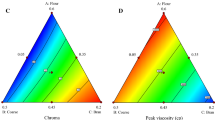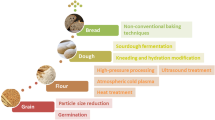Abstract
Many different raw materials have been proposed for producing nutritious gluten-free breads, but rarely, there is a parallel analysis of the effect of physical treatment on those ingredients. The aim of this study was to incorporate carob flour fractions of varying particle size on rice gluten-free breads prepared with carob/rice (15:85) flour blends. Carob flour particle size was controlled by fractionation or jet milling application. Quality features of gluten-free breads containing carob flour and commercially available gluten-free breads were compared. Carob flour addition led to breads with improved colour parameters, crumb structure, retarded firming and lower moisture loss compared to rice bread. Further improvement in specific volume, crumb hardness, protein and ash content and estimated glycaemic index (eGI) could be obtained by a careful selection of the particle size distribution of the carob flour. Carob breads prepared either with the coarsest or the finest fraction prepared using jet milling led to end products with the highest specific volume (≈2.2 g/cm3) and the lowest crumb hardness (≈5.5 N), although they had lower specific volume and harder crumbs than breads from commercial blends (≈3–4 g/cm3, 0.6–3.8 N). Nevertheless, rice-based bread made with the finest carob flour was superior considering its slower firming, protein content and lower eGI. The incorporation of carob flour obtained by jet milling in rice-based gluten-free breads led to end products with quality characteristics and sensory acceptance resembling commercial breads and high nutritional value.

Similar content being viewed by others
References
AACC International. (2012). Approved methods of analysis. 11th Ed. Methods: 08-01.01; 46-13.01; 32-07.01; 74-09.01. AACC International. St. Paul, MN, USA
AOAC. (1990). Method 935.36. Moisture content determination and method 985.29. Total dietary fiber in foods (enzymatic–gravimetric method), vol. II (15th ed.). Arlington, VA: Association of Official Analytical Chemists.
Barcenas, M., Altamirano-Fortoul, R., & Rosell, C. (2010). Effect of high pressure processing on wheat dough and bread characteristics. LWT- Food Science and Technology, 43(1), 12–19.
Batlle, I., & Tous, J. (1997). Carob tree: Ceratonia siliqua L.—promoting the conservation and use of underutilized and neglected crops. 17, Institute of Plant Genetics and Crop Plant Research (p. 78). Rome: Gatersleben/International Plant Genetic Resources Institute.
Chau, C. F., Wen, Y. L., & Wang, Y. T. (2006). Effects of micronisation on the characteristics and physicochemical properties of insoluble fibres. Journal of the Science of Food and Agriculture, 86(14), 1380–1386.
Chau, C. F., Wang, Y. T., & Wen, Y. L. (2007). Different micronization methods significantly improve the functionality of carrot insoluble fibre. Food Chemistry, 100, 1402–1408.
Cornejo, F., Caceres, P. J., Martinez-Villaluenga, C., Rosell, C. M., & Frias, J. (2015). Effects of germination on the nutritive value and bioactive compounds of brown rice breads. Food Chemistry, 173, 298–304.
de la Hera, E., Talegon, M., Caballero, P., & Gomez, M. (2013). Influence of maize flour particle size on gluten-free breadmaking. Journal of the Science of Food and Agriculture, 93(4), 924–932.
de la Hera, E., Rosell, C. M., & Gomez, M. (2014). Effect of water content and flour particle size on gluten-free bread quality and digestibility. Food Chemistry, 151, 526–531.
Dini, C., Garcia, M. A., & Vina, S. Z. (2012). Non-traditional flours: frontiers between ancestral heritage and innovation. Food & Function, 3(6), 606–620.
El Batal, H., & Hasib, A. (2013). Optimization of extraction process of carob bean gum purified from carob seeds by response surface methodology. Chemical and Process Engineering Research, 12, 1–8.
Gallagher, E., Gormley, T. R., & Arendt, E. K. (2003). Crust and crumb characteristics of gluten free breads. Journal of Food Engineering, 56(2–3), 153–161.
Gelencsér, T., Gál, V., Hódsági, M., & Salgó, A. (2008). Evaluation of quality and digestibility characteristics of resistant starch-enriched pasta. Food and Bioprocess Technology, 1, 171–179.
Goñi, I., Alonso, A. G., & Calixto, F. S. (1997). A starch hydrolysis procedure to estimate glycemic index. Nutrition Research, 17(3), 427–437.
Granfeldt, Y., Björck, I., Drews, A., & Tovar, J. (1992). An in vitro procedure based on chewing to predict metabolic responses to starch in cereal and legume products. European Journal of Clinical Nutrition, 46, 649–660.
Gularte, M. A., & Rosell, C. M. (2011). Physicochemical properties and enzymatic hydrolysis of different starches in the presence of hydrocolloids. Carbohydrate Polymers, 85, 237–244.
He, H., & Hoseney, R. C. (1990). Changes in bread firmness and moisture during long-term storage. Cereal Chemistry, 67, 603–605.
Holt, S. H., & Miller, J. B. (1994). Particle size, satiety and the glycaemic response. European Journal of Clinical Nutritition, 48(7),496–502.
Houben, A., Hochstotter, A., & Becker, T. (2012). Possibilities to increase the quality in gluten-free bread production: an overview. European Food Research and Technology, 235(2), 195–208.
Hwang, M. P., & Hayakawa, K. I. (1980). Bulk density of cookies undergoing commercial baking processes. Journal of Food Science, 45(5), 1400–1402.
ISO 937-1978. Determination of nitrogen (reference method).
Karababa, E., & Coşkuner, Y. (2013). Physical properties of carob bean (Ceratonia siliqua L.): an industrial gum yielding crop. Industrial Crops and Products, 42, 440–446.
Kim, B. K., Cho, A. R., Chun, Y. G., & Park, D. J. (2013). Effect of microparticulated wheat bran on the physical properties of bread. International Journal of Food Sciences and Nutrition, 64(1), 122–129.
Korus, J., Witczak, M., Ziobro, R., & Juszczak, L. (2009). The impact of resistant starch on characteristics of gluten-free dough and bread. Food Hydrocolloids, 23(3), 988–995.
Laureati, M., Giussani, B., & Pagliarini, E. (2012). Sensory and hedonic perception of gluten-free bread: comparison between celiac and non-celiac subjects. Food Research International, 46(1), 326–333.
Lazaridou, A., Duta, D., Papageorgiou, M., Belc, N., & Biliaderis, C. (2007). Effects of hydrocolloids on dough rheology and bread quality parameters in gluten-free formulations. Journal of Food Engineering, 79(3), 1033–1047.
Lionetti, E., Gatti, S., Pulvirentic, A., & Catassi, C. (2015). Celiac disease from a global perspective. Best Practice & Research Clinical Gastroenterology, 29, 365–379.
Marco, C., & Rosell, C. M. (2008). Breadmaking performance of protein enriched, gluten-free breads. European Food Research and Technology, 227, 1205–1213.
Mariotti, M., Pagani, M. A., & Lucisano, M. (2013). The role of buckwheat and HPMC on the breadmaking properties of some commercial gluten-free bread mixtures. Food Hydrocolloids, 30(1), 393–400.
Matos, M. E., & Rosell, C. M. (2011). Chemical composition and starch digestibility of different gluten free breads. Plant Foods for Human Nutrition, 66, 224–230.
Matos, M. E., & Rosell, C. M. (2013). Quality indicators of rice-based gluten-free bread-like products: relationships between dough rheology and quality characteristics. Food and Bioprocess Technology, 6, 2331–2341.
Matos, M. E., & Rosell, C. M. (2015). Understanding gluten-free dough for reaching breads with physical quality and nutritional balance. Journal of the Science of Food and Agriculture, 95(4), 653–661.
Miranda, J., Lasa, A., Bustamante, M. A., Churruca, I., & Simon, E. (2014). Nutritional differences between a gluten-free diet and a diet containing equivalent products with gluten. Plant Foods for Human Nutrition, 69(2), 182–187.
Moreira, R., Chenlo, F., & Torres, M. D. (2013). Rheology of gluten-free doughs from blends of chestnut and rice flours. Food and Bioprocess Technology, 6(6), 1476–1485.
Moroni, A. V., Dal Bello, F., & Arendt, E. K. (2009). Sourdough in gluten-free bread-making: an ancient technology to solve a novel issue? Food Microbiology, 26(7), 676–684.
Niba, L. L., Bokonga, M. M., Jackson, E. L., Schlimme, D. S., & Li, B. W. (2001). Physicochemical properties and starch granular characteristics of flour from various Manihot esculenta (cassava) genotypes. Journal of Food Science, 67(5), 1701–1705.
Novotni, D., Cukelj, N., Smerdel, B., Bituh, M., Dujmic, F., & Curic, D. (2012). Glycemic index and firming kinetics of partially baked frozen gluten-free bread with sourdough. Journal of Cereal Science, 55(2), 120–125.
Omary, M. B., Fong, C., Rothschild, J., & Finney, P. (2012). Effects of germination on the nutritional profile of gluten-free cereals and pseudocereals: a review. Cereal Chemistry, 89(1), 1–14.
Parada, J., & Aguilera, J. M. (2011). Review: starch matrices and the glycaemic response. Food Science and Technology International, 17, 187–204.
Phimolsiripol, Y., Mukprasirt, A., & Schoenlechner, R. (2012). Quality improvement of rice-based gluten-free bread using different dietary fibre fractions of rice bran. Journal of Cereal Science, 56(2), 389–395.
Protonotariou, S., Drakos, A., Evageliou, V., Ritzoulis, C., & Mandala, I. (2014). Sieving fractionation and jet mill micronization affect the functional properties of wheat flour. Journal of Food Engineering, 134, 24–29.
Protonotariou, S., Mandala, I., & Rosell, C. M. (2015). Jet milling effect on functionality, quality and in vitro digestibility of whole wheat flour and bread. Food and Bioprocess Technology, 8(6), 1319–1329.
Renzetti, S., & Rosell, C. M. (2016). Role of enzymes in improving the functionality of proteins in non-wheat dough systems. Journal of Cereal Science, 67, 35–45.
Sciarini, L. S., Ribotta, P. D., León, A. E., & Pérez, G. T. (2010). Effect of hydrocolloids on gluten-free batter properties and bread quality. International Journal of Food Science & Technology, 45(11), 2306–2312.
Sciarini, L. S., Ribotta, P. D., Leon, A. E., & Pérez, G. T. (2012). Incorporation of several additives into gluten free breads: effect on dough properties and bread quality. Journal of Food Engineering, 111(4), 590–597.
Storck, C. R., da Rosa Zavareze, E., Gularte, M. A., Elias, M. C., Rosell, C. M., & Dias, A. R. G. (2013). Protein enrichment and its effects on gluten-free bread characteristics. LWT-Food Science and Technology, 53(1), 346–354.
Thompson, T. (2009). In E. Gallagher (Ed.), The nutritional quality of gluten-free foods, in gluten-free food science and technology (pp. 42–51). Oxford: Wiley-Blackwell. doi:10.1002/9781444316209.ch4.
Trappey, E. F., Khouryieh, H., Aramouni, F., & Herald, T. (2015). Effect of sorghum flour composition and particle size on quality properties of gluten-free bread. Food Science and Technology International, 21(3), 188–202.
Tsatsaragkou, K., Yiannopoulos, S., Kontogiorgi, A., Poulli, E., Krokida, M., & Mandala, I. (2012). Mathematical approach of structural and textural properties of gluten free bread enriched with carob flour. Journal of Cereal Science, 56, 603–609.
Tsatsaragkou, K., Gounaropoulos, G., & Mandala, I. (2014a). Development of gluten free bread containing carob flour and resistant starch. LWT-Food Science and Technology, 58, 124–129.
Tsatsaragkou, K., Yiannopoulos, S., Kontogiorgi, A., Poulli, E., Krokida, M., & Mandala, I. (2014b). Effect of carob flour addition on the rheological properties of gluten-free breads. Food and Bioprocess Technology, 7(3), 868–876.
Vallons, K. J. R., Ryan, L. A. M., & Arendt, E. K. (2011). Promoting structure formation by high pressure in gluten-free flours. LWT-Food Science and Technology, 44(7), 1672–1680.
Wang,Y., Belton, P. S., Bridon, H., Garanger, E., Wellner, N., Parker, M. L., Grant, A., Feillet, P., & Noel, T. R. (2001). Physicochemical studies of caroubin: a gluten-like protein. Journal of Agricultural and Food Chemistry, 49, 3414–3419.
Zhu, K., Huang, S., Peng, W., Qian, H., & Zhou, H. (2010). Effect of ultrafine grinding on hydration and antioxidant properties of wheat bran dietary fiber. Food Research International, 43(4), 934–938.
Ziobro, R., Korus, J., Witczak, M., & Juszczak, L. (2012). Influence of modified starches on properties of gluten-free dough and bread. Part II: quality and staling of gluten-free bread. Food Hydrocolloids, 29(1), 68–74.
Acknowledgements
Financial support of the Spanish Ministry of Economy and Competitiveness (Project AGL2014-52928-C2-1-R) and the European Regional Development Fund (FEDER) is acknowledged.
Author information
Authors and Affiliations
Corresponding author
Rights and permissions
About this article
Cite this article
Tsatsaragkou, K., Kara, T., Ritzoulis, C. et al. Improving Carob Flour Performance for Making Gluten-Free Breads by Particle Size Fractionation and Jet Milling. Food Bioprocess Technol 10, 831–841 (2017). https://doi.org/10.1007/s11947-017-1863-x
Received:
Accepted:
Published:
Issue Date:
DOI: https://doi.org/10.1007/s11947-017-1863-x




